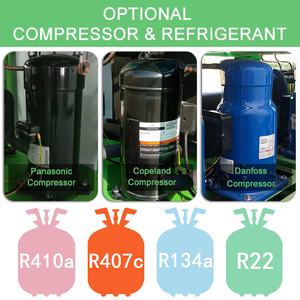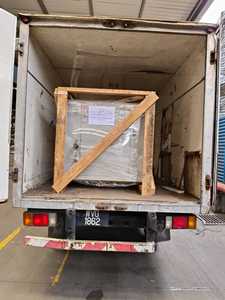(13704 products available)
























































































































































































R22 chillers are cooling machines that use R22 refrigerant to absorb heat from liquids and lower their temperatures. They can be divided into two main categories: air-cooled R22 chillers and water-cooled R22 chillers.
Air-cooled R22 chillers
Air-cooled R22 chillers are machines that use the air around them as a cooling medium to dissipate heat. They consist of an evaporator, compressor, condenser, expansion valve, and other components. The working process of air-cooled R22 chillers is as follows: first, the refrigerant absorbs heat from the water in the evaporator, then it evaporates into vapor, and next, it is compressed into high-pressure gas by the compressor. After that, the high-pressure gas passes through the condenser, where it releases heat into the air, and finally, the refrigerant turns back to liquid by the action of the expansion valve and repeats the cycle. Air-cooled R22 chillers have many advantages such as simple structure, easy installation, no need for cooling towers and water tanks, etc. They are suitable for small to medium-sized spaces or places where the water source is limited. However, air-cooled R22 chillers are also affected by ambient temperatures. Their cooling efficiency may decline in high-temperature environments.
Water-cooled R22 chillers
Water-cooled R22 chillers are devices that use water as a cooling medium to dissipate heat with the help of cooling towers. Their structure and working principle are similar to air-cooled R22 chillers. The difference is that the condensers of water-cooled R22 chillers need to dissipate heat through circulating water. This process requires the support of external cooling towers. The cooling towers can lower the temperature of circulating water by utilizing the air around them. Water-cooled R22 chillers usually have higher cooling capacities and efficiency than air-cooled chillers. They are suitable for occasions that require a large amount of cooling, such as large office buildings, shopping malls, industrial production lines, etc. Water-cooled R22 chillers also have relatively complex structures and higher maintenance requirements. Additionally, because they need to keep circulating water, they might consume more water resources and require more water treatment systems.
Generally, the functional performance of an r22 chiller depends on its mechanical components. Every part is designed to perform a specific function that contributes to the overall effectiveness of the machine. Here are some important parts of the chiller and their specifications:
Refrigerant:
A refrigerant is a chemical compound used to absorb heat from a chiller's hot environment. In the case of R22, it is a colorless gas with good heat absorption capabilities. Even though it was widely used, many manufacturers started to phase it out and look for alternatives that contained less or no chlorine.
Evaporator:
A chiller's evaporator absorbs heat from the circulating water before vaporizing the refrigerant. It is one of the critical components in determining if the machine will perform well. In a cooler environment, refrigerant pressure drops, and evaporation occurs while taking heat from the water.
Condenser:
The condenser's role is to release heat from the refrigerant to the air (or water, depending on the kind of condenser used) before changing the refrigerant back to liquid form. The process takes a reverse cycle from an evaporator, whereby heat is released instead of absorbing it.
Compressor:
A compressor's role is to receive low-pressure refrigerant gas from the evaporator and then increase the gas pressure. Higher pressure gases have more heat release capacity. Once the compressor goes into action, the refrigerant moves around the chiller's cooling system.
Expansion valve:
As the refrigerant moves through the chiller, it's led to the expansion valve. The component reduces the refrigerant's pressure before leading it back to the evaporator. The process allows the refrigerant to cool down before absorbing heat from the water.
R22 chiller maintenance is crucial to ensure the machine runs well and effectively cools the intended space. Remember that R22 refrigerant chiller machines have mechanical and electrical parts. Regular inspections and early detection can prevent minor to serious faults that may require costly repairs or replacements. Here are some maintenance tips to keep in mind:
R22 is an important refrigerant used in various refrigerating machines with cooling and heating functions. Due to the therapeutic effect it has on food and its processing, the R22 chiller is influential in the food and beverage industries.
Understand business needs and application scenarios
Consider factors like the industry, size, operating temperature, and humidity of the business premises. Determine the cooling capacity and performance requirements based on specific application scenarios. For example, commercial R22 air conditioning chillers may be preferred in the food processing industry.
Consider' energy efficiency
Opt for R22 chillers with high energy efficiency to reduce operating costs. Check the chiller's energy efficiency ratio (EER) or coefficient of performance (COP) and select models that meet or exceed specified energy efficiency standards.
Pay attention to product quality and brand
Choose reputable manufacturers and brands, as they are more likely to offer reliable products and good after-sales service. Research the manufacturer's history, production experience, and technical strength.
Check the refrigerant R22's environmental compliance
Although considering R22's performance and cost advantages, it is also important to pay attention to its environmental impact. Select some models that comply with environmental regulations, ensuring proper refriger recovery and recycling during equipment use and eventual disposal.
Consider installation and maintenance costs
Consider factors like installation complexity and maintenance requirements and assess the long-term costs of using the chiller.
Q: What are the differences between R22 and R410 refrigerants?
A: The main difference between R22 and R410 is that R22 is chlorine containing, and this compound harms the ozone layer. On the contrary, R410 is a blend of two fluorinated compounds, or so-called HFCs, that do not harm the ozone layer. The second difference is the temperature. R22 is still commonly used in chillers due to its high efficiency, but R410's popularity increased because it gives a better performance in low-temperature applications.
Q: Is R22 still in use?
A: India, the Philippines, and some African countries still use R22 in buildings and cooling systems due to the lower costs. However, in the European Union and the United States, the use of R22 in new systems has been banned since 2015 because, in 2010, the US Environmental Protection Agency identified it as harmful to the ozone layer.
Q: Is R22 chiller more efficient?
A: The efficiency of refrigerants is measured by the Global Warming Potential or GWP. Even though R22 has a higher GWP than some of its successors, it is still more efficient than R410A and R407C.